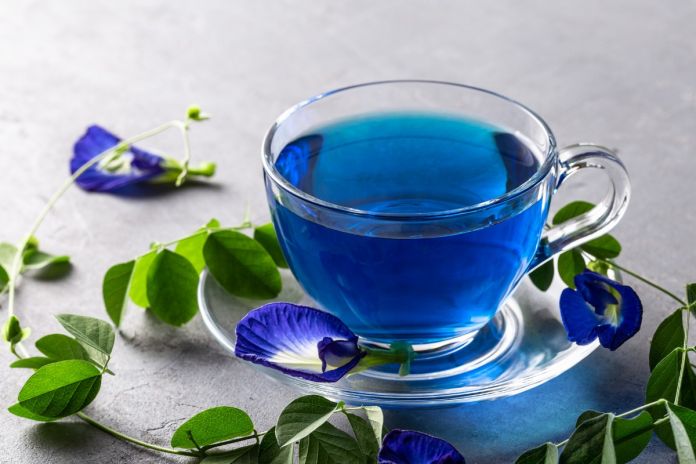Today’s trend is all about blue tea, however, did you know that blue tea is loaded with tons of health benefits? Blue tea is specifically made of the Butterfly Pea Flower/ Clitoria ternatea plant.
As I mentioned above that, blue tea is a popular food trend in recent times, owing to the wonderful benefits it confers, for human health, such as promoting weight loss, detoxifying the body, pacifying the mind, enriching skin texture and improving hair growth.
Nutritional Composition of Butterfly Pea Flower
This butterfly pea flower is loaded with nutrients which contribute to its health benefits. Did you know that it contains antioxidants, including anthocyanins, catechins, and quercetin, which help combat oxidative stress and inflammation in the body?
For your additional information, it is a source of vitamins such as vitamin C and minerals like iron and zinc, making it a nutritious addition to one’s diet.
The butterfly pea flower is not only just for visually appealing but also nutritionally dense. It also contains a variety of bioactive compounds that include,
- Anthocyanins: These water-soluble pigments give the flower its beautiful vibrant blue color which are known for their antioxidant properties, that helps to combat oxidative stress and reduce inflammation in our body.
- Flavonoids: It has also, flavonoids like quercetin and catechins that contributes to additional antioxidant benefits.
- Vitamins and Minerals: This Butterfly Pea Flower is a source of vitamin C, which supports immune function, and minerals such as iron and zinc, which are essential for various bodily functions.
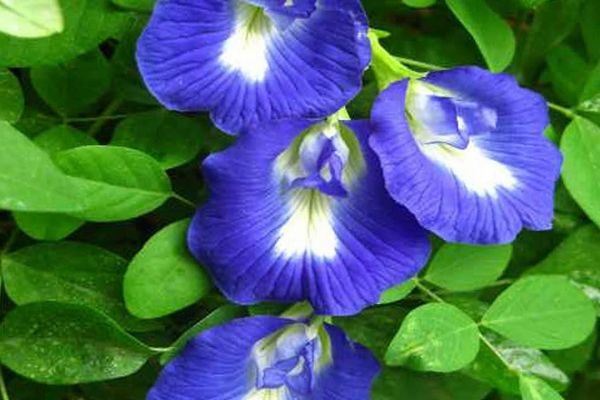
Source: Hug A Plant
Unveiling the Health Benefits of Blue Tea
1. Powerful Antioxidant Properties
Since Anthocyanins present in butterfly pea flowers are potent antioxidants that neutralize free radicals, thereby which helps in reducing oxidative stress and lowering the risk of chronic diseases such as cardiovascular disorders, certain cancers and many more.
2. Anti-inflammatory Effects
The compounds presence in the butterfly pea flowers exhibit anti-inflammatory effects, potentially alleviating conditions that are associated with inflammation, such as arthritis and inflammatory bowel diseases.
3. Improvement in Cognitive Function
The antioxidants in butterfly pea flowers support brain health by protecting against oxidative damage and improving cognitive function.
4. Support for Skin Health
Since Blue tea is drinking from ages. Traditionally it is believed that butterfly pea tea has been used to promote skin health. Its antioxidants help protect the skin from damage caused by UV radiation and environmental pollutants, contributing to a clearer complexion and possibly reducing the signs of aging.
5. Digestive Benefits
Blue tea has mild laxative effects, that aiding in digestion and promoting gastrointestinal health. Also, it is believed to have prebiotic properties that support the growth of beneficial gut bacteria.
6. Potential Anti-diabetic Properties
Butterfly pea flower help to regulate blood sugar levels, making it a potential therapeutic agent for managing diabetes.
Scientific Evidence That Supporting Blue Tea
However, there is some scientific evidence of the potential health benefits of butterfly pea flower and blue tea in more depth:
- Antioxidant Activity: Studies have found the antioxidant activity of butterfly pea flower extracts, attributing this to its high anthocyanin content. These antioxidants help in scavenge free radicals and protect cells from oxidative damage.
- Anti-inflammatory Effects: Butterfly pea flower extracts exhibit anti-inflammatory properties by inhibiting inflammatory cytokines and enzymes. This could potentially translate into therapeutic benefits for inflammatory conditions in humans.
- Cognitive Function: Studies have shown promising results regarding the effects of anthocyanins on cognitive function and neuroprotection. These compounds may enhance memory, learning, and overall brain health.
- Skin Protection: The photoprotective effects of butterfly pea flower extract have been explored, which indicates its potential as a natural ingredient in sunscreens and skincare products. It helps protect against UV-induced skin damage and premature aging.
- Metabolic Health: Some studies suggest that butterfly pea flower extracts may influence glucose metabolism and insulin sensitivity, which are crucial factors in managing diabetes and obesity-related conditions.
Culinary and Cultural Uses of Blue Tea
Apart from its health benefits, did you know that blue tea is valued for its culinary versatility and aesthetic appeal. In Southeast Asia, this is commonly used to naturally colour food and beverages, including rice, desserts, and cocktails. The vibrant blue color of this tea makes it a favorite ingredient among chefs and mixologists worldwide.
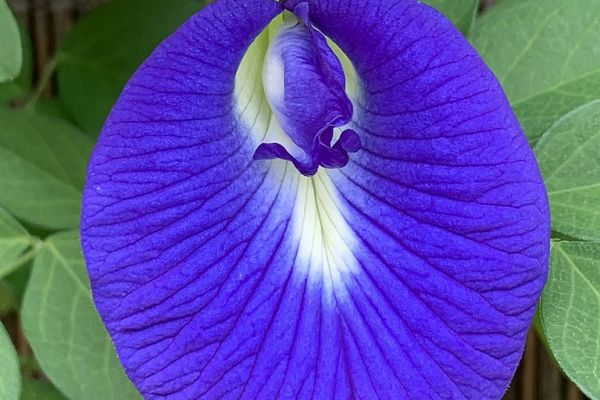
How to Prepare Blue Tea
It is very simple and straightforward to make blue tea from butterfly pea flowers. Firstly, you need to pluck up the flower from the plant then you need to dry it up, or simply you can use the powder available from specialty tea stores or online.
Ingredients
- Use dried butterfly pea flowers (available from specialty tea stores or online).
How to prepare
- Boil water and pour it over the dried flowers in a teapot or cup.
- Keep it for 3-5 minutes to extract the color and beneficial compounds.
- Blue tea can be enjoyed plain or with added flavorings such as honey, lemon, mint, or ginger for a personalized taste experience.
- Serve hot or cold over ice, depending on your preference and the season.
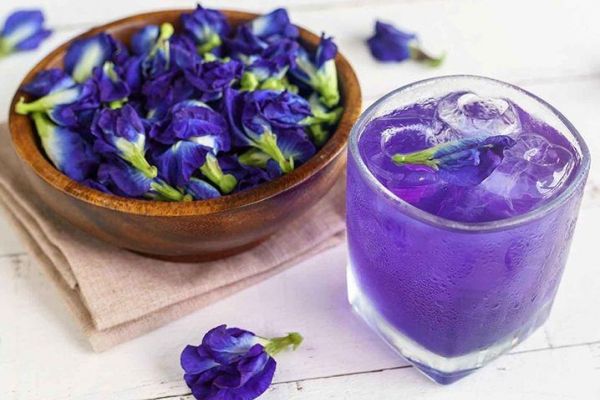
Source: FoodYaari
Tips for Purchasing Blue Tea
Here are the tips for purchasing blue tea,
- Check the Ingredients: Before buying te products you needs to check whether it contains only butterfly pea flowers or other natural ingredients without additives or artificial colors.
- Quality and Freshness: Look for dried butterfly pea flowers that are vibrant in color and aromatic, indicating freshness and quality.
- Organic and Sustainably Sourced: Choose organic blue tea products to minimize exposure to pesticides and support sustainable farming practices.
- Read Reviews: Before purchasing online, read customer and packaging of the blue tea product from different sellers.

Source: ubuy nepal
Does Blue Tea helps in weight loss?
- Metabolism Support: As we already know that Blue tea contains antioxidants, particularly with anthocyanins.
- Digestive Aid: Some herbal teas, which includes blue tea, it is believed to have mild digestive benefits. Improved digestion can contribute to better nutrient absorption and waste elimination, which are important for overall wellness and potentially weight loss.
- Caffeine-Free Option: Unlike many traditional teas like green or black tea, blue tea is naturally caffeine-free.
- Hydration: Drinking herbal teas like blue tea can contribute to your daily fluid intake without added sugars or calories.
- Calorie-Free Beverage: Blue tea itself is calorie-free when consumed without added sweeteners or flavorings.
- Culinary Versatility: Its vibrant color and subtle flavor can enhance dishes and beverages, promoting enjoyment without guilt.
Conclusion
As we already know that blue tea derived from the butterfly pea flower offers a spectrum of health benefits supported by both traditional wisdom and modern scientific research.
Besides, its antioxidant and anti-inflammatory properties it has a potential effect on cognitive function and blood sugar regulation, which is natural infusion holds promise as a functional beverage for holistic health.
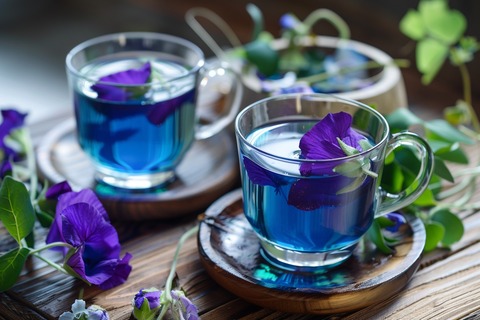
By exploring the diverse benefits of blue tea, you will not only indulge in a unique sensory experience but also harness centuries-old botanical knowledge to enhance your journey towards a healthier lifestyle.
Explore the world of blue tea and discover its wonders for yourself—a journey that blends aesthetics with wellness in every soothing sip.
FAQs
How does blue tea get its color?
The deep blue color of blue tea comes from the natural pigments called anthocyanins found in the butterfly pea flower petals. These water-soluble pigments impart a striking blue hue to the tea when steeped in hot water.
Is blue tea caffeine-free?
Yes, blue tea is naturally caffeine-free, making it a suitable choice for those who wish to avoid caffeine or are sensitive to it. It can be enjoyed at any time of day without affecting sleep patterns or causing jitteriness.
Also, read more about, Uses of Blue Spirulina and its benefits
